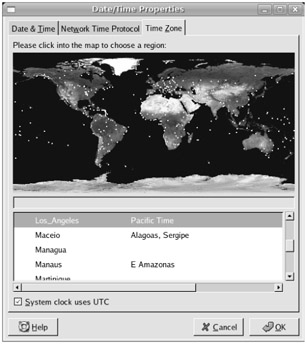Certification Objective 3.07-System Configuration Files
Red Hat sets up a number of key configuration files in the /etc/sysconfig directory. You can configure them with a text editor, with text commands, or in many cases with a Red Hat graphical tool. Many of the non-network system configuration files are discussed in this section.
It's fastest if you know how to configure these systems directly using text commands or by directly editing the key configuration file. However, if you forget how to manage one or two configuration commands or files, the Red Hat graphical tools can be a lifesaver.
I address only those systems not already covered in other chapters.
Non-network /etc/sysconfig Files
Let's return to the /etc/sysconfig directory and discuss some of the non-network configuration files listed in Table 3-3. This section covers only those files that are less likely to be of interest on the Red Hat exams. More important files are covered in other chapters. Some files can be edited directly; others can be configured with other Red Hat tools discussed in the following section.
| File in the /etc/sysconfig Directory | Description |
|---|---|
| clock | Contains defaults for the system clock, including time zone, UTC, and ARC (Alpha CPU-based) settings. If UTC=true, the BIOS is set to the atomic realization of Greenwich Mean Time. |
| firstboot | If RUN_FIRSTBOOT=YES, then you can start the First Boot process with the firstboot command, if you're in runlevel 5. |
| grub | Lists the hard disk with your /boot drive, assuming you're using the GRUB boot loader. |
| hwconf | Lists peripherals detected by kudzu. Do not edit this file! |
| i18n | Sets the default language. |
| init | Specifies the graphics and associated colors during the boot process. |
| iptables | Includes the iptables firewall commands that run when you boot Linux. |
| iptables-config | Adds configuration for adding iptables rules. |
| irda | Controls infrared devices. |
| kernel | Specifies defaults when you update the kernel. |
| keyboard | Contains keyboard configuration data: |
| kudzu | Configures hardware detection during the boot process, as it relates to serial ports, DDC (Display Data Channel) between the monitor and video card, and PS/2 ports. |
| ntpd | Specifies synchronization with the hardware clock after synchronizing with a remote NTP (network time protocol) server. |
| pcmcia | Contains PCMCIA configuration data. If PCMCIA=yes, Linux loads PCMCIA modules on boot. |
| pm | Configures hibernation characteristics. |
| rhn/ | Directory with Red Hat Network configuration. |
GUI Configuration Utilities
It's important to know how to configure RHEL 5 by hand, because it's the most efficient way to control everything on your Linux system. It's faster on the Red Hat exams, where time is of the essence. There are a number of good GUI configuration tools available; almost all of them are "front ends" that edit text configuration files, which you could edit directly.
However, there's a lot to learn about Linux. Learning how to edit all key Linux configuration files can be more than some RHCT/RHCE candidates can handle. While you should learn how to edit these files by hand, you may not have time. You may get nervous during the Red Hat exams and forget details. In these cases, the Red Hat GUI tools can be a lifesaver.
| On the Job | The text mode setup tool is a front end to a number of other tools you can view from the text console: authentication, firewall, keyboard, network, printer, service, time zone, and GUI display configuration. You can start the tool with the setup command. While they may be faster than GUI tools, some of these tools do not have the same capabilities as GUI tools. |
Date/Time Properties
With the Date/Time Properties configuration tool, you can set the date, time, timezone, and NTP server for your system. You can start it in one of three ways in the GUI: run the system-config-date or system-config-time command, or choose System | Administration | Date and Time. This opens the Date/Time Properties window shown in Figure 3-8.

Figure 3-8: The Date/Time Properties window
Keyboard Configuration Tool
The Keyboard Configuration tool allows you to reselect the keyboard associated with your system. You can start it in one of two ways in the GUI: run the system-config-keyboard command or choose System | Administration | Keyboard. The options are the same as those you saw during the installation process. Results are recorded in /etc/sysconfig/keyboard.
If you're studying for the RHCE, Red Hat has just added NTP configuration and troubleshooting to the Exam Prep guide. For more information, see Chapter 13.
EAN: 2147483647
Pages: 227